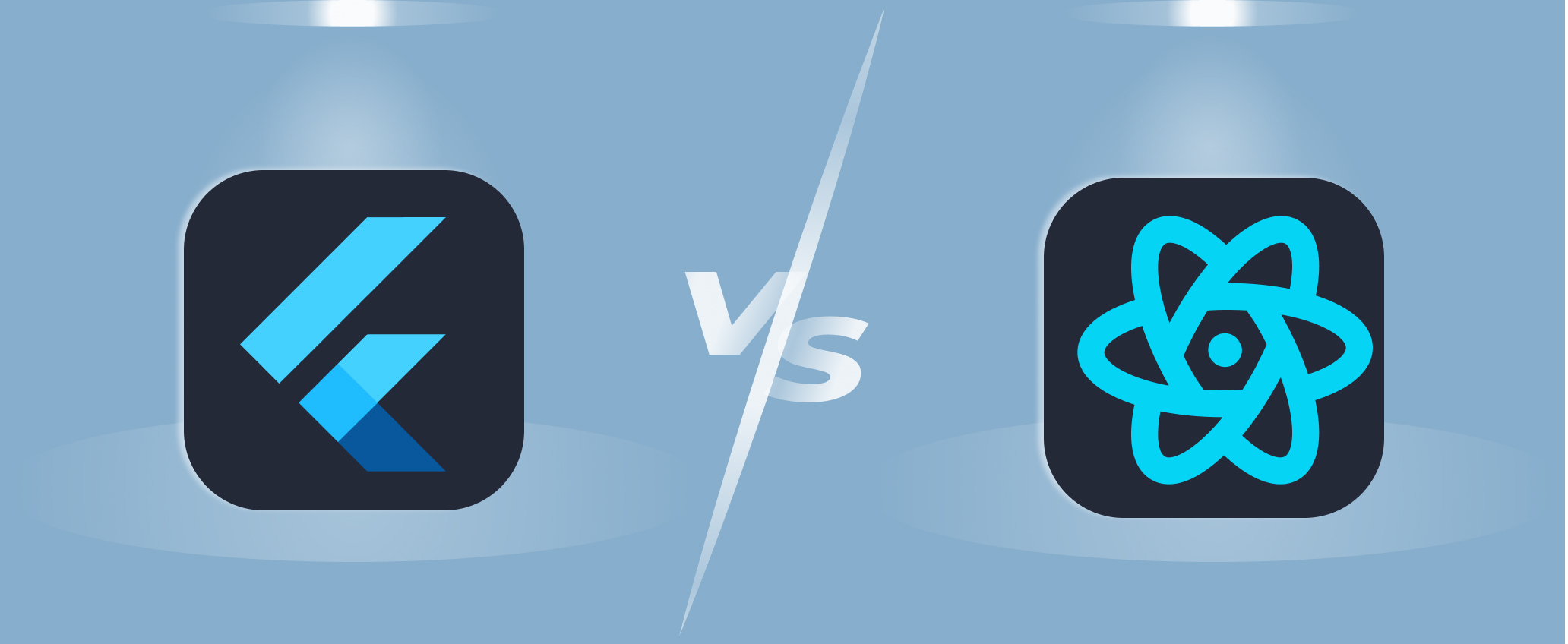Flutter and React Native are the two most commonly used technologies for cross-platform mobile app development. Both these platforms come with several pros and cons, Today, in the Flutter vs React Native debate, we will find the best technology for your upcoming development tasks in 2024.
The choice between hybrid mobile app development and native development paths is crucial, with each offering distinct advantages. This exploration of Flutter and React Native will not only trace their evolution but also compare their current strengths, guiding you in selecting the right framework and when to consider hiring an Android developer proficient in these technologies.
Flutter vs React Native: The Basics
Flutter, introduced in 2017, has quickly risen in popularity thanks to its complete, customizable widgets and the ability to compile to native code, which guarantees performance that is virtually indistinguishable from native apps. With Google’s backing, Flutter has seen exponential growth in its community and tooling ecosystem. As of 2024, it boasts a vibrant community of over 2 million developers, with a 30% increase in adoption rate in the last year alone.
React Native, on the other hand, leverages the widespread familiarity of JavaScript, making it an attractive option for web developers transitioning to mobile app development. Since its release in 2015, React Native has been adopted by giants like Instagram, Facebook, and UberEats, demonstrating its capability to handle complex, high-performance apps with a near-native user experience. The framework’s usage statistics show steady growth, with over 1.5 million developers and an adoption rate increasing by 20% in the past year.
| Feature | Flutter | React Native |
|---|---|---|
| Programming Language | Dart ✓ | JavaScript ✓ |
| Performance | Direct compilation to native code ✓ | Good, with occasional bridge overhead ✕ |
| Development Environment | Flexible, any IDE ✓ | JavaScript ecosystem tools ✓ |
| UI Components & Customization | Highly customizable widgets ✓ | Native components, custom UI possible ✕ |
| Community & Support | Rapidly growing ✓ | Large and mature ✓ |
| Learning Curve | Steeper for non-Dart developers ✕ | Gentler, especially for JS developers ✓ |
| Code Reusability | Excellent, single codebase ✓ | Very good, with some exceptions ✕ |
| Hot Reload | Supported ✓ | Supported ✓ |
| Documentation | Comprehensive and detailed ✓ | Extensive, variable quality ✕ |
| Deployment Time | Faster development cycle ✓ | Potentially slower ✕ |
| Cost | Lower due to efficiency ✓ | Higher due to platform specifics ✕ |
| Open Source | Yes, permissive license ✓ | Yes, permissive license ✓ |
Comparing the Core Features of Flutter and React Native

In the Flutter vs React Native comparison, understanding their technical capabilities is crucial. However, performance dynamics, user interface, and design flexibility, along with platform support, play significant roles in this discussion.
Performance Dynamics
- Flutter: Stands out for its high performance due to the Dart language and ahead-of-time (AOT) compilation, offering smooth animations and transitions.
- React Native: Provides near-native performance, with some overhead due to the JavaScript bridge communicating with native elements.
User Interface and Design Flexibility
- Flutter: Boasts a rich set of customizable widgets, allowing for the creation of complex, bespoke UIs with a consistent look.
- React Native: Utilizes native components, ensuring that apps feel right at home on each platform.
By leveraging the React Native technology we developed a hybrid mobile app for parents and kids to join local physical activities.
Platform Support
- Flutter: Offers extensive platform support beyond mobile, including web, desktop (Windows, macOS, Linux), and even embedded devices.
- React Native: Primarily focuses on mobile platforms, though community efforts like React Native for the Web extend. We recently developed a custom mobile app to bridge the native technologies by using gRPC in React native.
Community and Ecosystem
- Flutter: Despite being newer, it has a rapidly growing community and a burgeoning ecosystem of packages and plugins.
- React Native: Benefits from a larger, more established community and a vast ecosystem, given its longer presence in the market.
Development and Maintenance Costs
- Flutter: This can reduce costs by using a single codebase for multiple platforms, though Dart developers may be less common.
- React Native: Might increase costs for projects requiring extensive native functionality, due to the need for native developers alongside React Native experts.
Furthermore, if you want custom Android app development by leveraging Flutter or React Native framework you can hire Android developer for technical support.
Considerations for Choosing Between Flutter and React Native

Scalability and Future Growth
- Flutter is highly scalable, thanks to its unified codebase approach. It’s designed to support large, complex applications with high performance. Additionally, Flutter’s compatibility with Fuchsia could open new avenues for applications in the IoT (Internet of Things) space.
- React Native offers scalability primarily through its vast ecosystem and the ability to integrate with native modules. This makes it possible to optimize performance-critical parts of the application using native code, although it may require more effort compared to Flutter.
Development and Runtime Efficiency
- Flutter’s hot reload and a comprehensive set of widgets accelerate the development process, allowing for quick iterations. Its compiled nature leads to efficient runtime performance, often surpassing React Native in CPU-intensive tasks.
- React Native benefits from the JavaScript ecosystem, facilitating the use of numerous libraries and tools that can speed up development. While its bridge architecture may impact runtime efficiency, recent advancements, and upcoming architectural changes aim to mitigate these issues.
Ecosystem and Third-Party Libraries
- Flutter has seen rapid growth in its ecosystem, with a flourishing repository of packages and widgets that cater to a wide range of functionalities. Furthermore, adding Google’s support ensures continuous expansion and update of its libraries.
- React Native benefits from its maturity and the extensive JavaScript ecosystem, offering a vast selection of libraries and tools that can be easily integrated into projects. Moreover. this extensive support network can be a decisive factor for teams leveraging existing JavaScript libraries.
Community Support and Resources
- Flutter boasts a rapidly growing community, with forums, social media groups, and an abundance of online courses and tutorials. Moreover, Google’s investment in community events and resources ensures developers have ample support.
- React Native has a well-established community, backed by years of development and contributions from individuals and companies worldwide. Furthermore, this large community offers an extensive range of tutorials, forums, and conferences, making it easier for new developers to get up to speed.
Future Trends and Predictions of Flutter and React Native

Both Flutter and React Native are backed by tech giants (Google and Facebook, respectively), ensuring their continued development and support. However, their future trajectories may be influenced by broader industry trends and developer preferences.
Updates and Roadmap
- Flutter has positioned itself as a universal development platform, with ongoing projects to improve its performance. Furthermore, Google’s commitment to Fuchsia, an operating system designed to run on all types of devices, suggests Flutter.
- React Native continues to focus on improving the bridge between JavaScript and native code, aiming to enhance performance. Additionally, Facebook’s investment in React Native’s re-architecture (Fabric) promises significant improvements in usability and performance.
Industry Adoption Trends
- The Flutter community is growing rapidly, with a noticeable trend towards adopting more visually complex and high-performance apps. Moreover, its versatility across different platforms makes it a compelling choice for businesses looking to expand beyond mobile.
- React Native maintains strong popularity among startups and established companies valuing quick development cycles and leveraging web development expertise. However, the framework’s maturity and extensive ecosystem continue to make it a safe choice for many.
Development and Maintenance Costs
It’s essential to consider not only the initial development costs but also the long-term maintenance and update expenses. Hiring Android developers proficient in Flutter or React Native can significantly influence the project’s budget and timeline.
Flutter’s single codebase approach might offer cost efficiencies, particularly for businesses aiming to target multiple platforms beyond Android. Conversely, React Native’s reliance on JavaScript and its vast ecosystem can be an advantage for projects leveraging existing web development resources.
FAQs: Flutter vs React Native
language and offers a comprehensive widget set for creating custom UIs, enabling high performance across platforms. React Native, leveraging JavaScript, allows for sharing code with web applications, providing a near-native user experience by bridging JavaScript code with native components.
Yes, both Flutter and React Native are excellent choices for custom Android app development. Flutter provides a high degree of UI customization with its rich widget library, while React Native offers a quicker transition from web to mobile development thanks to its use of JavaScript.
Startups looking to hire Android developers might choose based on the specific needs of their project and the existing skills of their team. Flutter could be more suitable for projects requiring intricate UI designs or high performance across multiple platforms. React Native might be preferred for its faster development cycle and the ability to leverage existing JavaScript expertise.
While developers can learn and work with both frameworks, they typically specialize in one due to the differences in underlying technologies—Dart for Flutter and JavaScript for React Native. Companies might need to consider this when looking to hire Android developers for their projects.
Yes, both frameworks are free and open-source, providing developers with the flexibility to customize and enhance their capabilities. This open-source nature supports a vibrant community of contributors, continually expanding the frameworks’ features and Android app development services.
Conclusion
In the Flutter vs React Native comparison for 2024, the choice hinges on several key factors, including the project’s specific UI requirements, developer expertise, and long-term maintenance considerations. If you want to develop a cross-platform app by leveraging these technologies to support your community, you can collaborate with an expert mobile app developer for a robust solution.
Stay Tuned for Latest Updates
Fill out the form to subscribe to our newsletter





